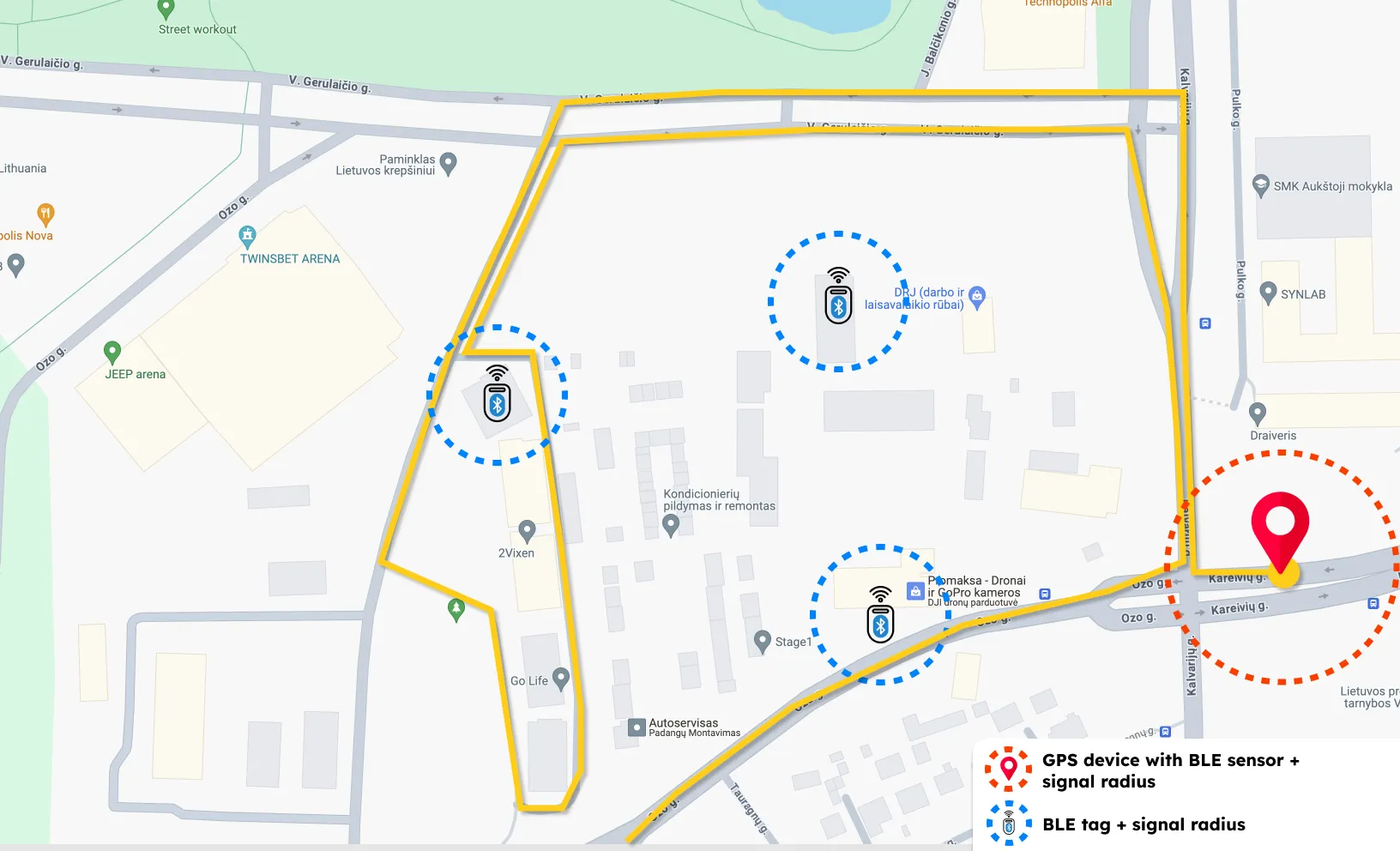BLE asset tracking: What is? How it works? Why is this necessary?
29.4.2024 | Rostislav AdutskevichIf you are tired of regular GPS tracking/monitoring, the standard set of features, and standard problems with used technologies, then today we offer to dive into something new.
We are starting a series of articles about Asset tracking using BLE beacons and tags.
Today we will talk about:
- What is BLE tracking, and how does it work?
- In what areas is it used, and how can it help businesses?
- Why have we decided to start talking about this?
Spoiler: we have already started developing a software solution for working with BLE sensors.
So, let's go!
What is it?
Let's start with what BLE is
BLE, or Bluetooth Low Energy, is a version of Bluetooth optimized for reduced energy consumption. This technology is often used in devices where energy consumption is critical, such as battery-operated devices, and in devices that transmit small amounts of data over long intervals between transmission sessions.
However, do not confuse BLE with Bluetooth Classic in your headphones, car, or music player. These two types of devices are incompatible with each other. Meanwhile, there are everyday devices that support both types of connections (Bluetooth Dual mode): smartphones, laptops, etc.
This was a brief dive into dry theory. You can learn more about Bluetooth technology at this link.
From all the above, what interests us specifically is BLE technology and how it can be used for tracking the location and condition of various assets.
Bluetooth monitoring and tracking
Since the advent of BLE, the industry has found numerous applications for BLE in tracking both movable and immovable assets. From tracking construction tools, luggage, and keys, to monitoring systems for cargo containers, navigation, and tracking within buildings and restricted areas for businesses.
Why use BLE? It's simple: BLE is a wireless method that allows for precise location determination, efficient use of device battery, and cost reduction. More and more manufacturers have started offering trackers that support BLE, which can detect nearby BLE sensors and determine their position relative to them.
But let's discuss everything in order.
How does it work?
BLE beacons, BLE tags, trackers supporting BLE
Let's immediately differentiate these three concepts by their type of tracking.
BLE beacons
Typically, they are used for monitoring stationary units. Beacons send signals that are received by other devices, such as mobile phones and telematic devices (trackers) with integrated BLE modules.
BLE beacons are stationary devices that do not transmit data other than their identifier (ID) and are usually used for indoor navigation.
The GPS signal significantly weakens inside buildings, especially in large or underground spaces. In such conditions, BLE beacons help track locations inside buildings, which is crucial for the efficient operation of large warehouses, operational centers, and airports. Placing multiple beacons at different points in a space helps provide continuous coverage and real-time location display.
Beacons are installed on stationary units, they are usually small and generally less noticeable than other tracking devices.
Examples of BLE beacon usage:
- Automatic registration of vehicles/trailers returning to base.
- Real-time tracking of staff routes.
- Monitoring of staff activities at high-traffic sites.
- Monitoring the status of various machines/equipment and other stationary equipment to determine if a machine is in its place and has been serviced.
BLE tags
Used for tracking non-stationary/movable units.
BLE tags are devices that continuously emit a signal received by devices with built-in Bluetooth modules around them. To use this information, it is necessary for the devices that "capture" data from the tags to then transmit this data to a telematics platform via an internet connection for further processing and display to the end-user.
How do BLE tags work? BLE tags are used for tracking movable assets. They are resistant to various impacts, visible, and can measure environmental parameters, such as temperature and humidity. The difference between tags and beacons is that tags allow not just to detect proximity, but to precisely determine the location of a unit. This is achieved because the tags can transmit not only their ID and all the above-listed information, but also the signal strength (RSSI).
 In the image, 3 tags and a GPS device with an integrated BLE module are shown with their signal radii. As the GPS device moves along the yellow track, it will pass by the tags, and their radii will overlap. At the moment of overlap, the GPS device will "see" the tag and send data to the system about this.
In the image, 3 tags and a GPS device with an integrated BLE module are shown with their signal radii. As the GPS device moves along the yellow track, it will pass by the tags, and their radii will overlap. At the moment of overlap, the GPS device will "see" the tag and send data to the system about this.
Examples of BLE tags usage:
- Construction: tags help track tools at various construction sites, both inside buildings and outdoors, ensuring they are in the right place and preventing theft.
- Emergency services: tags help track equipment that might have been left behind in a hurry, such as medical, repair, or firefighting equipment.
- Agriculture: tags are used to monitor the location of agricultural equipment, preventing its loss over large areas.
- Urban development: tags help track various service vehicles, waste containers, bus stops, and other elements of urban infrastructure.
Unlike traditional GPS trackers, BLE tags are smaller, simpler to use, and do not require special technical skills for installation.
Why have we started talking about this?
We are looking for tasks and cases from our partners in the field of tracking with BLE devices.
Besides being a rather interesting direction of monitoring, with which Gurtam had not previously worked specifically, we have received a significant number of requests from our partners about the need for a similar solution.
Our team is already working on implementing a software solution for our partner community. If you have encountered such requests from your clients or would like to start offering services based on BLE technology and devices, we would be glad to learn about your cases and tasks to consider them in the development of a new solution from the GPS-Trace platform.







